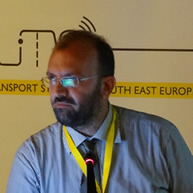Dr. Evangelos Mitsakis is an elected Research Director of CERTH‐HIT. He has participated in more than 30 EU research projects in the field of transport, as well as in numerous national and EU transport studies. His main research interests lie in transport systems modelling and optimization, Intelligent Transportation Systems and C-ITS and systems’ resilience.
1. Can you tell us about CERTH and your role in the project?
The Hellenic Institute of Transport of the Centre for Research and Technology Hellas (HIT-CERTH) constitutes a research institution, the main objective of which is to conduct and support applied research activities in the field of transportation in Greece, specifically on issues relating to the organization, operation, planning and development of transportation systems, including Intelligent Transport Systems (ITS).
In the context of the nuMIDAS project, HIT-CERTH was tasked with developing from a conceptual and computational point of view the algorithms, comprising the back end of the nuMIDAS toolkit. Moreover, HIT-CERTH was engaged in designing the use cases of the nuMIDAS toolkit, by considering the current state of the art as well as previous relevant experience and achievements in previous relevant EU-funded projects. Finally, it was highly engaged in implementing the required interfaces between the front-end and back-end.
2. What are your main challenges in working and preparing the data and algorithms for the dashboard?
The first challenge faced within the course of nuMIDAS project involved a concrete understanding of the specific needs of nuMIDAS pilot cities. Subsequently, a second challenge faced was to translate these needs into specific algorithmic requirements and problems to be solved. From this point on, the next challenges involved the identification of the exact data required for solving the identified problems and the implementation of high-quality algorithmic/ solution frameworks.
Finally, another important challenge was the identification of the optimal way of providing the results/ outputs of the developed algorithms/ solutions to the end-users of the toolkit and assuring their validity and reliability. For this reason, closed interactions had taken place between members of HIT-CERTH and representatives of nuMIDAS pilot cities.
3. How do you think clear data and analysis of trends can be helpful for decision-making in the mobility sector?
The continuous evolvement of new technologies and solutions have affected several operational and tactical dimensions of transportation systems. Therefore, there is an ever-growing need to adapt these dimensions to the new prevailing conditions. This becomes possible only through the availability and proper analysis of data generated by innovative transportation/ mobility modes and policies that operate within/applied to transportation systems. In particular, the analysis of these data replaces and is supplemented by conventional techniques utilized for planning transportation systems (e.g., four step modelling). Moreover, the analysis of these data calls for the exploitation of new techniques that stem from the scientific field of Applied Statistics and Artificial Intelligence. By that means, transport planners and policymakers have a unique opportunity to make better decisions and exploit in a more efficient manner the capabilities and potentials offered by new technologies and solutions. The nuMIDAS toolkit has been designed and developed considering the aforementioned principles and opportunities.





